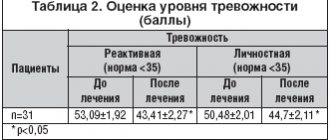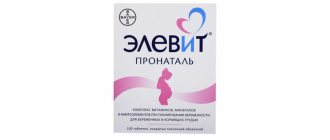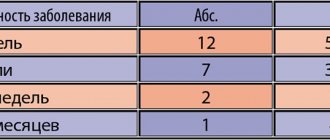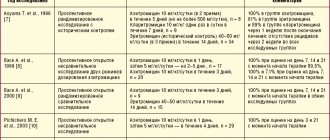Introduction
The drug tofacitinib is registered in the Russian Federation under the trade name Yaquinus (ATC code - L04AA29).
Belongs to the group Antineoplastic and immunomodulatory agents / immunosuppressants / selective immunosuppressants [13][14]. Tofacitinib is a selective and reversible inhibitor of Janus kinase 1 and 3 (JAK1 and JAK3). The selectivity for JAK2 in tofacitinib, in contrast to baricitinib, is less pronounced. The drug is approved for use in the treatment of rheumatoid and psoriatic arthritis, plaque psoriasis and ulcerative colitis [15]. Clinical studies are studying the effectiveness of tofacitinib therapy in patients with juvenile idiopathic arthritis, systemic lupus erythematosus, systemic scleroderma, vitiligo, alopecia, atopic dermatitis, etc. [7].
It should be taken into account that tofacitinib is a substrate of MDR1, but when prescribed in therapeutic doses it does not inhibit it; it is metabolized mainly by the CYP3A4 isoenzyme and, to a lesser extent, by CYP2C19. The dose of the drug requires adjustment in patients with impaired renal function [15][16].
ESCAPE (tablets)
After the polyps were removed from my esophagus, I started having bouts of nausea, especially in the morning.
It didn’t matter whether I was full or hungry, just the smell of food made me sick. Perhaps something happened in the stomach during the operation, since the polyps were in the lower third. The polypectomy operation itself was difficult, with bleeding. Saw Motilak, Mezim, Gaviscon. And so on for a couple of months. When I finally managed to pour water or broth into myself, I was tormented by a feeling of heaviness and fullness in my stomach. Sometimes there was pain. Gradually, the feeling of joy from delicious food disappeared, the quality of life fell every day. I couldn’t go to a cafe with my friends because I felt sick. I couldn’t cook for my family because I was sick. Every day I felt sick. I tried cerucal - but my head was spinning, my heart was pounding, my blood pressure was jumping. I decided to endure it myself. br>After a couple of weeks, when I miraculously did not vomit right into my husband’s scrambled eggs, I decided to go to the doctor. I don’t know why I realized it so late, probably the polypectomy discouraged me from visiting doctors. The gastroenterologist diagnosed acute gastritis. To do this, I had to undergo a gastroscopy, but it is necessary, so it is necessary.
The doctor prescribed medications - Mezim, Omeprazole, No-Shpa. I continued to feel nauseous. My stomach hurt. I returned to my doctor, he decided to change the therapy, adding Escape. This is a drug based on bismuth tripotassium dicitrate, it should help with gastritis both with and without Helicobacter pylori. It supposedly forms a film on the surface of the stomach)
The instructions stated that it not only removes the symptoms, but also eliminates the cause of the disease, protects the stomach and restores damage to its mucosa. I really hoped that the new treatment plan would finally bring results and I was not mistaken: the attacks of nausea began to come less and less often, morning sickness disappeared completely, and I was finally able to cook food calmly.
I took Escape 2 times a day, 2 tablets at a time, about half an hour before meals. The instructions also have an alternative option to take 1 tablet 4 times a day, but it was inconvenient for me, I didn’t eat that many times a day. The tablets are small, swallow without problems, and have no unpleasant odor. The drug suited me, it is definitely good and the benefits from it are obvious.
During gastroscopy after the Escape course, a decrease in inflammation of the gastric mucosa was noted, which may be due to the fact that the nausea has gone away. Escape has few contraindications, so I recommend it for such problems, but it is still advisable to first be examined by a doctor.
Studies of tofacitinib as a pathogenetic therapy for COVID-19
The prerequisites for studying the role of tofacitinib in COVID-19 were observations of the significant role of various cytokines, and primarily IL-6, in the pathogenesis of patient decompensation and the development of cytokine storm and acute respiratory distress syndrome (ARDS). It is known that after the binding of cytokines to the corresponding membrane receptors, the intracellular signaling pathway JAK-STAT (Signal Transducer and Activator of Transcription) is activated, which regulates the effects of more than 50 cytokines, interferons and growth factors [7]. Tofacitinib can also significantly reduce the number of pathological natural killer cells, which some authors assign to one of the leading roles in the development of acute damage to internal organs during a cytokine storm [8]. A certain impetus for discussing the role of tofacitinib in the treatment of coronavirus infection was provided by research data and the start of a clinical trial (CT) of another JAK kinase inhibitor - baricitinib, however, unlike it, tofacitinib does not have the ability to block AP-2-associated protein kinase 1 and cyclin G- associated kinase, which are responsible for the endocytosis of the SARS-CoV-2 virus [11].
We did not find any experimental studies of the effectiveness of tofacitinib in COVID-19 or other ARDS.
A search for clinical trials in the ClinicalTrias.gov registry identified 2 studies: NCT04390061 and NCT04332042. Both studies are declared as open-label. Recruitment of patients has not begun. The randomized trial NCT04390061 (TOFACoV-2) will evaluate the efficacy of two weeks of tofacitinib 10 mg twice daily and hydroxychloroquine 200 mg three times daily versus hydroxychloroquine alone. Enrollment of 116 patients is planned, with evaluation results expected in October 2021. The second study, registration number NCT04332042, is a prospective cohort study that will enroll 50 patients. In this case, it is planned to study the preventive effect of tofacitinib at a dose of 10 mg 2 times a day, prescribed on the first day after hospitalization, on the severity of COVID-19, primarily on the risk of ARDS, mortality, and the safety of the drug.
Some conclusions may be drawn from a subgroup analysis of CT NCT04330495 (Santander, Spain), which is billed as a high-quality study and will be aimed at studying the prophylactic effect of hydroxychloroquine in patients receiving biological anti-inflammatory therapy, including tofacitinib. As with the above-mentioned CTs, patient recruitment for this CT has not begun (a total of 800 participants are planned to be recruited), and preliminary results are expected no earlier than November 2020.
A search in the CT registries ISRCTN, DRKS (Germany), ANZCTR (Australia and New Zealand), the European Clinical Trials Registry, the Chinese ChiCTR registry, UMIN-CTR (Japan), the national registries of Thailand, the Netherlands, India and Singapore did not find any CTs other than mentioned above.
An expert review by Italian experts, published on May 5, recommends use, including tofacitinib, in patients with rheumatic diseases and autoimmune lesions of the gastrointestinal tract when COVID-19 infection is detected [10]. A similar recommendation for discontinuation of tofacitinib in patients with ulcerative colitis with SARS-CoV-2 infection is contained in a recent article by American gastroenterologists [2]. “Clinical caution” in the use of tofacitinib is recommended by the authors of the British guidelines for the management of patients with inflammatory bowel disease. They do not make recommendations for discontinuation of the drug in uninfected patients, but classify them as an “average risk” group in which stricter adherence to nonspecific prophylaxis (social distancing) is required [4].
Instructions for use ESCAPELLE®
This drug is intended solely for emergency contraception and does not replace regular hormonal contraception. Repeated use of Escapelle® during one menstrual cycle is not recommended.
Emergency contraception does not prevent pregnancy in all cases.
If the time of sexual intercourse is unknown or more than 72 hours have passed since unprotected sexual intercourse, pregnancy may occur. In this regard, the use of Escapelle® after the second sexual intercourse may be ineffective. If menstruation is delayed by more than 5 days, if there is a change in the nature of menstruation that occurred on time, or if pregnancy is suspected for any other reason, pregnancy should be excluded. If pregnancy occurs after using Escapelle®, you should be aware of the possibility of ectopic pregnancy.
The absolute risk of ectopic pregnancy appears to be low because levonorgestrel prevents ovulation and fertilization. Ectopic pregnancy can develop despite the appearance of uterine bleeding. In this regard, levonorgestrel is not recommended for use in the presence of risk factors for ectopic pregnancy (salpingitis or a history of ectopic pregnancy).
Escapelle® is not recommended for use in patients with severe liver failure.
In case of severe intestinal absorption disorders (for example, Crohn's disease), the effectiveness of Escapelle® may be reduced.
After taking Escapel®, normal menstruation usually occurs at the expected time. Sometimes your period may start a few days earlier or later than expected. It is recommended to consult a doctor to select or adjust regular contraception. If Escapel® was used against the background of regular hormonal contraception, and menstruation does not occur during the subsequent 7-day break in taking the contraceptive, pregnancy must be excluded.
Repeated use of the drug during the same menstrual cycle is not recommended due to the possibility of its disruption.
There is limited evidence that requires further confirmation that the contraceptive effectiveness of Escapelle may decrease with increasing body weight or BMI. All women, regardless of their weight and BMI, should take emergency contraception as soon as possible after unprotected intercourse.
The drug contains lactose monohydrate (142.5 mg). Patients with congenital galactose or lactose intolerance or glucose-galactose malabsorption syndrome are not recommended to take the drug.
Escapelle® is not effective as regular contraception and can only be used as an emergency contraceptive. Women who regularly use emergency contraception should consult their doctor to select a method of permanent contraception.
The use of emergency contraception does not eliminate the need to protect against sexually transmitted diseases.
Impact on the ability to drive vehicles and operate machinery
Studies have not been conducted to identify the possible effect of the drug on the ability to drive a car and operate machinery.
Preclinical safety data
In animal experiments, virilization of female fetuses was observed when high doses of levonorgestrel were used.
Preclinical studies have not identified any specific potential harm to humans other than those presented elsewhere in the product summary.
Safety of tofacitinib
It should be noted that, according to the instructions for medical use, tofacitinib is contraindicated in patients with creatinine clearance less than 40 ml per minute, infection with hepatitis B and C viruses, patients receiving therapy with IL-6 receptor antagonists, which include tocilizumab and sarilumab, with severe and active infections, children, lactating and pregnant women, and administration at a dose of 10 mg 2 times a day is contraindicated if there is a history of venous thromboembolism (deep veins, pulmonary embolism), hereditary blood clotting disorders, patients with heart failure (without indication of severity) [15]. This circumstance significantly limits the use of tofacitinib in patients with COVID-19. The instructions for medical use provide recommendations for reducing the daily dose of the drug from 20 mg to 10 mg (5 mg 2 times a day) in patients with rheumatoid arthritis and the presence of at least one cardiovascular risk factor, as well as discontinuing the drug in patients at risk [17].
Among the adverse reactions of tofacitinib, the development of anemia, lymphopenia and neutropenia should be noted, which, when laboratory values reach below 500 cells/ml (for lymphocytes and neutrophils) or 90 g/l (for hemoglobin), require discontinuation of the drug. In this context, it should be noted that some authors consider lymphopenia a risk factor for the development of ARDS and negative outcome of COVID-19 [12].
Another complication of drug therapy is the development of respiratory tract infections. This fact is reflected in the instructions for use and confirmed by a meta-analysis by Khoo JK et al., published in May 2021 on the website of the journal Rheumatology [5][15]. The literature reports a case of SARS-CoV-2 infection in a 33-year-old patient with ulcerative colitis while taking tofacitinib (10 mg twice daily) [3].
The association of tofacitinib use with the risk of thromboembolic complications and death from them has also been shown in a number of clinical trials [6][9].
The presence of these risks (risk of developing infections, lymphomas and other malignant tumors, arterial or venous thrombosis, increased mortality from cardiovascular accidents in people over 50 years of age with at least one cardiovascular risk factor) when using tofacitinib led to the appearance of a special safety notice - black box warning - in the instructions for use of the drug in the USA [1][16] and the release of a special EMA notice that restricts the use of the drug [17][18].
Instructions
Registration number: Trade name of the drug: Escape® International nonproprietary name or generic name : bismuth tripotassium dicitrate Dosage form: film-coated tablets
Composition per tablet:
Active substance: bismuth tripotassium dicitrate – 300.00 mg, in terms of bismuth oxide – 120.00 mg. Excipients: corn starch - 54.22 mg, povidone (medium molecular weight polyvinylpyrrolidone, povidone K 25) - 42.00 mg, polacrilin (potassium polacrilin) - 20.00 mg, magnesium stearate - 3.78 mg. Shell: AquaPolish® P white 019.49 MS [Hydroxypropyl methylcellulose (E 464) – 7.80 mg; hydroxypropylcellulose (E 463) – 1.30 mg; stearic acid (E 570) – 0.91 mg; talc (E 553b) – 1.30 mg; polyethylene glycol – 0.39 mg; titanium dioxide (E171) – 1.30 mg] – 13.00 mg.
Description
Round, biconvex, film-coated tablets of white or almost white color, with a faint odor of ammonia, white or almost white on the break. Pharmacotherapeutic group: Antiulcer, antiseptic intestinal and astringent. ATX code: [A02ВХ05]
Pharmacological properties
Pharmacodynamics
Gastroprotective and antiulcer agent with bactericidal activity against Helicobacter pylori. It also has anti-inflammatory and astringent effects.
In the acidic environment of the stomach, insoluble bismuth oxychloride and citrate are precipitated, and chelate compounds are formed with the protein substrate in the form of a protective film on the surface of ulcers and erosions. Thus, the drug forms a protective layer, which for a long period of time protects the affected areas of the mucous membrane from the influence of aggressive factors. By increasing the synthesis of prostaglandin E, mucus formation and bicarbonate secretion, it stimulates the activity of cytoprotective mechanisms, increases the resistance of the gastrointestinal mucosa to the effects of pepsin, hydrochloric acid, enzymes and bile salts. Leads to the accumulation of epidermal growth factor in the defect area. Reduces the activity of pepsin and pepsinogen.
Pharmacokinetics
Practically not absorbed from the gastrointestinal tract. It is excreted mainly in feces. A small amount of bismuth entering the plasma is excreted from the body by the kidneys.
Indications for use
- functional dyspepsia not associated with organic diseases of the gastrointestinal tract;
- chronic gastritis and gastroduodenitis in the acute phase, including those associated with Helicobacter pylori;
- peptic ulcer of the stomach and duodenum in the acute phase, including those associated with Helicobacter pylori;
- irritable bowel syndrome, which occurs predominantly with symptoms of diarrhea.
Contraindications
- increased individual sensitivity to the components of the drug;
- pregnancy;
- breastfeeding period;
- taking medications containing bismuth;
- chronic renal failure;
- children under 4 years of age.
Use during pregnancy and breastfeeding
Bismuth tripotassium dicitrate is contraindicated for use in pregnant women. If it is necessary to use the drug during lactation, breastfeeding should be stopped.
Directions for use and doses
Inside. The duration of the course of treatment and the dose of the drug are determined by the attending physician individually for each patient, depending on the nature of the disease.
For adults and children over 12 years of age, the drug is prescribed 1 tablet 4 times a day, 30 minutes before meals (breakfast, lunch, dinner) and at night, or 2 tablets 2 times a day 30 minutes before meals (breakfast, dinner).
Children aged 8 to 12 years are prescribed 1 tablet 2 times a day 30 minutes before meals (breakfast, dinner).
Children aged 4 to 8 years are prescribed a dose of 8 mg/kg/day; Depending on the child’s body weight, 1-2 tablets are prescribed per day (respectively, in 1-2 doses per day). In this case, the daily dose should be as close as possible to the calculated dose (8 mg/kg/day).
The tablets are taken 30 minutes before meals with a small amount of water.
It is recommended to swallow the tablet whole, without chewing or crushing, with a sufficient amount of water. It is not recommended to take the tablets with milk. The duration of treatment is usually from 4 to 8 weeks. After finishing taking the drug, it is not recommended to take medications containing bismuth (for example, Vikalin, Vikair) for 2 months.
To eradicate Helicobacter pylori, it is advisable to use Bismuth tripotassium dicitrate in combination with antibacterial drugs that have anti-Helicobacter activity.
Side effects
The following adverse events noted with the use of bismuth tripotassium dicitrate are distributed according to the frequency of occurrence in accordance with the following gradation: very often (≥ 1/10); often (≥ 1/100, < 1/10); uncommon (≥ 1/1000, < 1/100); rare (≥ 1/10,000, < 1/1,000); very rare (<1/10,000).
From the gastrointestinal tract: very often - black stool; uncommon – nausea, vomiting, diarrhea or constipation.
Allergic reactions: infrequently - skin rash, itching; very rarely - anaphylactic reactions.
From the nervous system: very rarely - with prolonged use in high doses
- encephalopathy associated with the accumulation of bismuth in the central nervous system.
Side effects are reversible and disappear quickly after discontinuation of the drug.
Overdose
When using the drug in doses tens of times higher than recommended, or with prolonged use of excessive doses of the drug, bismuth poisoning may develop.
Symptoms: dyspepsia, rash, inflammation of the oral mucosa, characteristic darkening in the form of blue lines on the gums; with long-term use in doses exceeding the recommended ones, renal function may be impaired.
These symptoms are completely reversible when the drug is discontinued.
Treatment: there is no specific antidote. In case of an overdose of the drug, gastric lavage, intake of enterosorbents and symptomatic therapy aimed at maintaining kidney function are indicated. In case of overdose, the administration of saline laxatives is also indicated. Further treatment should be symptomatic. In case of impaired renal function, accompanied by a high level of bismuth in the blood plasma, complexing agents – dimercaptosuccinic and dimercaptopropanesulfonic acids – can be administered. With the development of severe renal dysfunction, hemodialysis is indicated.
Interaction with other drugs
For half an hour before and half an hour after taking the drug, it is not recommended to take other medications internally, as well as take food and liquids, in particular antacids, milk, fruits and fruit juices. This is due to the fact that when taken orally simultaneously, they can affect the effectiveness of bismuth tripotassium dicitrate.
The drug reduces the absorption of tetracyclines.
The drug is not used simultaneously with other drugs containing bismuth, since the simultaneous use of several bismuth drugs increases the risk of side effects, including the risk of encephalopathy.
special instructions
The drug should not be used for more than 8 weeks. It is not recommended to exceed the established daily doses for adults and children during treatment. During treatment with the drug, you should not use other drugs containing bismuth (see section “Interaction with other drugs”). At the end of a course of treatment with the drug in recommended doses, the concentration of the active substance in the blood plasma does not exceed 3 - 58 mcg/l, and intoxication is observed only at concentrations above 100 mcg/l.
When using bismuth tripotassium dicitrate, stool may turn dark due to the formation of bismuth sulfide.
Sometimes there is a slight darkening of the tongue. Alcohol consumption is not recommended during therapy.
Effect on the ability to drive vehicles and machines There is no data on the effect of Escape® film-coated tablets on the ability to drive vehicles and machines.
Release form
Film-coated tablets, 120 mg.
10 or 14 tablets in a blister pack made of polyvinyl chloride film and printed varnished aluminum foil.
4 or 8 blister packs along with instructions for use are placed in a cardboard pack.
Storage conditions
Store at a temperature not exceeding 25 °C. Keep out of the reach of children.
Best before date
3 years. Do not use after the expiration date stated on the packaging.
Vacation conditions
Over the counter.
Marketing authorization holder/organization receiving consumer complaints
PJSC OTCPharm, Russia, 123317, Moscow, st. Testovskaya, 10 Tel.: +7 (800) 775-98-19 Fax www.otcpharm.ru




